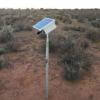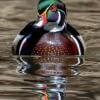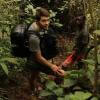Acoustic sensors enable efficient and non-invasive monitoring of a wide range of species, including many that are difficult to monitor in other ways. Although they were initially limited in application scope largely due to cost and hardware constraints, the development of low-cost, open-source models like the Audiomoth in recent years has increased access immensely and opened up new avenues of research. For example, some teams are using them to identify illicit human activities through the detection of associated sounds, like gunshots, vehicles, or chainsaws (e.g. OpenEars).
With this relatively novel dimension of wildlife monitoring rapidly advancing in both marine and terrestrial systems, it is crucial that we identify and share information about the utility and constraints of these sensors to inform efforts. A recent study identified advancements in hardware and machine learning applications, as well as early development of acoustic biodiversity indicators, as factors facilitating progress in the field. In terms of limitations, the authors highlight insufficient reference sound libraries, a lack of open-source audio processing tools, and a need for standardization of survey and analysis protocols. They also stress the importance of collaboration in moving forward, which is precisely what this group will aim to facilitate.
If you're new to acoustic monitoring and want to get up to speed on the basics, check out these beginner's resources and conversations from across the WILDLABS platform:
Three Resources for Beginners:
- Listening to Nature: The Emerging Field of Bioacoustics, Adam Welz
- Ecoacoustics and Biodiversity Monitoring, RSEC Journal
- Monitoring Ecosystems through Sound: The Present and Future of Passive Acoustics, Ella Browning and Rory Gibb
Three Forum Threads for Beginners:
- AudioMoth user guide | Tessa Rhinehart
- Audiomoth and Natterjack Monitoring (UK) | Stuart Newson
- Help with analysing bat recordings from Audiomoth | Carlos Abrahams
Three Tutorials for Beginners:
- "How do I perform automated recordings of bird assemblages?" | Carlos Abrahams, Tech Tutors
- "How do I scale up acoustic surveys with Audiomoths and automated processing?" | Tessa Rhinehart, Tech Tutors
- Acoustic Monitoring | David Watson, Ruby Lee, Andy Hill, and Dimitri Ponirakis, Virtual Meetups
Want to know more about acoustic monitoring and learn from experts in the WILDLABS community? Jump into the discussion in our Acoustic Monitoring group!
Header image: Carly Batist
Background in Computer Science, Developing Acoustic AI Tech at Synature
- 0 Resources
- 1 Discussions
- 4 Groups
Sea Mammal Research Unit Univ' St Andrews



- 0 Resources
- 13 Discussions
- 4 Groups
- @crazybirdguy
- | Him
Just a birder
- 0 Resources
- 6 Discussions
- 12 Groups
- @tom_august
- | he/him
Computational ecologist with interests in computer vision, citizen science, open science, drones, acoustics, data viz, software engineering, public engagement



- 4 Resources
- 48 Discussions
- 5 Groups
I am both head of the Innovation department and a biodiversity consultant at the Biotope consultancy. Originally a botanist and GIS expert, I specialise in the management of innovation projects, in particular software and technological products dedicated to biodiversity.
- 0 Resources
- 0 Discussions
- 6 Groups
- @chmod000
- | he/they
I build sensing and perceiving hardware that is designed to address issues that matter to me. That ranges from assistive technologies, to conservation ecology, and connecting individuals with place and each other.
- 0 Resources
- 0 Discussions
- 7 Groups
- @ARobillard
- | He/Him
A conservation data scientist and field ecologist with broad interest in the application of machine learning and population genetics to the conservation of threatened species. Alex has conducted field studies throughout central and south America, the Caribbean, and North America.
- 1 Resources
- 0 Discussions
- 7 Groups
- @pbull
- | he/him
DrivenData
Engineer and AI for Good leader working on bringing machine learning tools to social impact organizations.
- 0 Resources
- 0 Discussions
- 8 Groups
St. Lawrence University
Professor of Biology at St. Lawrence University
- 0 Resources
- 2 Discussions
- 13 Groups
- @SamuelHertz
- | He/Him/His
I'm a PhD researcher at Royal Holloway University of London (Centre for GeoHumanities) researching modalities of sound-sensing technologies across climate and conservation sciences. Interested in ethics and histories of acoustic monitoring as well as new visualization methods.
- 0 Resources
- 3 Discussions
- 10 Groups
- @AliceMuller
- | she/her
I am an environmental scientist working in international community development and community led ecosystem restoration
- 0 Resources
- 0 Discussions
- 1 Groups
- 0 Resources
- 0 Discussions
- 4 Groups
April 2024
June 2024
July 2024
event
July 2023
event
June 2023
May 2023
April 2023
Passive Acoustic Monitoring - Malagasy Training Workshop
9 May 2022 4:10pm
Help with AudioMoth configuration for bat recording
17 February 2022 1:31pm
Apply now: Women in Conservation Technology Programme, Kenya
8 March 2022 12:00am
BirdCLEF 2022 Kaggle Challenge
 The Cornell Lab of Ornithology
The Cornell Lab of Ornithology
2 March 2022 12:00am
Acoustic monitoring - sharks
23 February 2022 5:31pm
Introducing the WILDLABS On the Edge Fellows
10 February 2022 12:00am
Using rechargeable lithium-ion batteries for AudioMoths and/or Swift's
13 October 2021 5:32pm
25 October 2021 7:05pm
Actually it's interesting. I think it might be a good opportunity to think about how we can transition to rechargeable batteries in the field. Shipping them is possible if you follow postal rules and pay for hazardous material charges. But it needs to be planned in advance. Anyways, might be a good conversation to have in the community. But there also needs to be other foundational work like understanding how they're used, getting chargers in the field, and how to interface rechargeables to standard equipment.
25 October 2021 8:02pm
I've taken rechargeable batteries on planes no problem - NiMH can go in checked luggage. I use NiMH D batteries for the Swift's, because they take more and so it still lasts long. The Audiomoth is harder, because it's just the 3 AAs and even with lithium-ion you only get ~1 month. The drop off to NiMH is like a week, from my (minimal) trial-and-erroring.
20 January 2022 3:58am
We've been using 18650 lithium ion protected cells in our BAR recorders since 2013. The protected cells are great because the protection circuitry kicks in to disconnect the battery and save it from being dicharged too much. It also protects against short circuit.
So if you did want to give 18650 batteries a try then I'd recommend a Keystone 1043P (P for polarised so you can only fit the battery one way) battery holder and KeepPower protected 18650. There are a few other brands too that fit that battery holder ok but that's a common consistent brand.
Eizfan and XTAR make good chargers.
Most of our customers use them in the same continent and drive or road freight their recorders to site and so don' thave any problems shipping them.
We've heard of some problems on planes taking them as hand luggage and it's just luck of the draw if the particular person you encounter in the baggage area knows what their lithium ion battery policy is. I've usually heard of I think attempts to get this claried at the airline level has lead to a run around too.
Some people get to check them in if the batteries are fitted into the battery holders because they consider it built in like a phone or laptop. The spare batteries often go on as hand luggage. We have plastic battery cases to hold the cells for travel.
If you're sending it overseas we find that DHL, UPS and Fdex seem to take about a month to get the paperwork sorted out to give you permission on your account to ship lithium ion batteries with your recorders. Once you have permission though you can do it whenever you need to in the future for subsequenct studies. Look up the IATA regulations for packing lithium ion batteries with your equipment. You'll need to know this so you can tell DHL etc what permission you need and what you typically do. We use UN3481 packing instruction 966 section II becasue our cells are <20Wh and we can ship 5kg of batteries in a carton along with our recorders.
https://www.iata.org/en/publications/newsletters/iata-knowledge-hub/what-to-know-about-how-to-ship-lithium-batteries/
Mark Calder
Frontier Labs www.frontierlabs.com.au
Special session on "Open-Source and Free Tools for Bioacoustics" at the ASA Meting in Denver
3 January 2022 2:27pm
14 January 2022 12:13pm
Do you know if there are plans for remote attendance?
14 January 2022 1:19pm
Unfortunately, the ASA is currently planning to do an in-person meeting only. Things may change if the COVID situation doesn't improve in May, but it is hard to predict at this point.
Bioacoustics Webinar: Primates You May Have Missed
 Wildlife Acoustics
Wildlife Acoustics
14 January 2022 12:00am
GroupGets: AudioMoth Underwater Case
 Open Acoustic Devices
Open Acoustic Devices
11 January 2022 12:00am
New Paper: HydroMoth Testing
 Remote Sensing in Ecology & Conservation
Remote Sensing in Ecology & Conservation
5 January 2022 12:00am
Deep Learning for Marine Ecology and Conservation
 arXiv (Journal)
arXiv (Journal)
20 December 2021 12:00am
batch/automated cloud processing
27 January 2021 6:13am
18 October 2021 8:08am
Hi Antoine, did you know about our bioacoustic recorders? https://frontierlabs.com.au/ . They have the best sound recording quality and built in GPS. You can have a listen to Australia here https://data.acousticobservatory.org/projects/1 . The Australian Acoustic Observatory uses 400 of our Solar BARs across Australia and the recordings are published for anyone to use.
Unfortunately there isn't software to do an easy bird census. Do you need to know every bird you can hear or just the presence of one species?
Best regards, Mark
9 November 2021 4:24pm
Wanted to chime with another option. My lab develops OpenSoundscape, a Python software package for training machine learning models for bioacoustic detection, especially convolutional neural networks. Check it out at http://opensoundscape.org/
I see that the list of bioacoustic softwares was mentioned earlier in the thread (thanks Carly!) - I'm always on the lookout for new softwares to add to that, so drop me a line if you see a package that is currently maintained and relevant to bioacoustics but is not included on the list.
(Here's the link: https://github.com/rhine3/audiomoth-guide/blob/master/resources/analysis-software.md)
9 November 2021 9:48pm
Hi all,
For everyone's reference but also a new one for your list Tessa (just checked and it isn't there yet) -
Fuentes, M., Salamon, J., Zinemanas, P., Rocamora, M., Paja, G., Román, I. R., ... & Bello, J. P. (2021). Soundata: A Python library for reproducible use of audio datasets. arXiv preprint arXiv:2109.12690. https://arxiv.org/abs/2109.12690.
MBARI shares trove of marine acoustic data
 Monterey Bay Aquarium Research Institute
Monterey Bay Aquarium Research Institute
5 November 2021 12:00am
Opportunity: μMoth v1.1 Group buy
 Group Gets
Group Gets
4 November 2021 12:00am
Deploying 'Ears' in Ecosystems: Using Bioacoustics to Monitor Bird Species
 Gabriel Kiarie
Gabriel Kiarie
21 October 2021 12:00am
What value would you place on regular status updates from your acoustic recorder?
23 September 2021 1:13am
18 October 2021 5:41am
Our research typically involves mountainous areas within protected areas in Greece.
18 October 2021 7:36am
Hi Astaras, I'm Mark Calder one of the engineers at Frontier Labs. Yes we think that the energy used in sending a message by satellite once per week will get quickly replaced with the solar panel. We plan to send a short message with battery capacity remaining and card space remaining once per week typically. Probably also that sound was recorded in the last recording period. That is the microphone signal output was not flat fine. That can happen if the mic is broken off for example.
Obviously if you don't get a message from one of your recorders at the set time then that's cause for concern. It can take 4 hours to aquire a satellite and send the message though so you'd probably wait until the next day to make that judgement. The battery in a Solar BAR lasts for about a month with 24/7 recording if there is no more solar so it should be able to send out messages during long rain periods.
We'll be starting this project later this year. If you can think of other info to have in the messages please let me know. My email is [email protected] if that's more convenient.
18 October 2021 4:35pm
Hi Nicole--
We've already chatted about this function, and I think the answer is "quite a bit" for a lot of deployments. The more accurately the proposed function tracked microphone status the better, though even something to the effect of "I'm still getting a signal from this microphone" even if there was no more nuanced quality information than a yes/no would still be better than what much of the field is doing right now.
I think the question is how much this would add to the cost of the unit + how much whatever data service you're using would add to the ongoing costs but I'd imagine that Frontier are still figuring out those specifics.
Tech Tutors: How do I analyze large acoustic datasets using PAMGuard?
14 October 2021 3:42pm
Technical Difficulties: What’s The Worst That Can Happen?
 David Savage
David Savage
12 October 2021 12:00am
Arbimon terms of service
7 October 2021 5:24pm
8 October 2021 8:36pm
Hi David!
It sounds like Rainforest Connection and its affiliates reserve the right to use your acoustic data and its labels to train and/or test sound identification algorithms.
In my opinion, Rainforest Connection is unlikely to "scoop" the direct ecological or conservation research outputs of your data, which could be what your collaborators would be most concerned about.
However, if one of your research goals is methods development (e.g. publishing trained sound classifiers or experimenting with different machine learning approaches), you may want to directly ask Rainforest Connection for clarification on this part of their terms of service.
Sidenote: one the most significant bottlenecks for developing accurate machine learning classifiers is a lack of labeled data. The bioacoustics community would certainly benefit from the open publication of more labeled data!
Tessa
11 October 2021 3:24pm
Tessa--
Thanks for chiming in. I agree with a lot of what you're saying, both about what RFCX is likely to actually be doing and about the need for more open labeled datasets. However, unfortunately, a lot of times the academic incentives of individual research groups don't align well with the needs of the field more broadly.
This honestly might be a good topic for a broader discussion: how do we balance the ideals of a strongly FOSS-influenced conservation tech field with the incentives of academia, which include both publishing and (in the case of some universities including mine) monetizing data and research.
How do I analyze large acoustic datasets using PAMGuard?
 Jamie Macaulay
Jamie Macaulay
7 October 2021 12:00am
Bioacoustics Webinar: Creatures of the Night
 Wildlife Acoustics
Wildlife Acoustics
4 October 2021 12:00am
Incidental recording of people (in an IRB context)
30 June 2021 5:13pm
2 July 2021 3:01pm
I haven't needed to go through an IRB for acoustic collections yet, but I have had landowners ask this. My response has been that we filter out incidental conversations with ML automatically. For an IRB, you will probably need to be specific about how and when you do this. The responses I have had have been very mixed and any objections are based on incorrect assumptions and knowledge....or a flat out "no way" before even hearing how it works - usually after hearing the words "continuous recording" on their property. Others are happy and excited to see what is going on. It seems to be an educational task and it isn't easy amidst the current privacy debates, not to mention political climate.
Please keep the board updated. I'm sure your IRB experience with acoustic monitoring deployments will be valuable to others here.
22 September 2021 7:16am
We are filming with the Australian Acoustic Observatory soon with one of the Solar BARs we created (it's continuously recording for four years!) and were wondering if recording our people chat would constitute audio vandalism? lol
Deep learning module for PAMGuard
19 August 2021 2:07pm
27 August 2021 4:32pm
Thanks heaps for the info @jamie_mac ...looks really cool and the blog is amazing too!
I dare say you might see quite a few excited responses from the community!
All the best,
Rob
1 September 2021 6:37pm
Thanks Rob! Hopefully it turns out to be a useful tool.
Just to reiterate for folk, there are links to tutorials and a beta version in the blog post.
How do I use animal-borne imaging technology in marine and terrestrial environments?
 Kyler Abernathy
Kyler Abernathy
16 August 2021 12:00am
Webinar: Bioacoustics and Engagement
 Wildlife Acoustics
Wildlife Acoustics
19 July 2021 12:00am
WILDLABS Tech Tutors: Season 3
6 July 2021 12:00am
Kickstarter for Terra acoustic monitoring project
4 June 2021 4:09pm
GroupGets: μMoth Now Available
 Open Acoustic Devices
Open Acoustic Devices
27 May 2021 12:00am
Tools similar to BirdNet for analyzing avian recordings?
13 May 2020 5:03pm
24 April 2021 8:50am
Almost a year since the original post, but just commenting that I've been having some pretty good success with BirdNET which has been working fine in the past few weeks I've been using it.
7 May 2021 6:51pm
Dear Thomas I'm really interested by your experience, how did you use birdnet?
I would like to monitor a area for a certain amount of time with birdnet automatically identifying the bird around, is it possible to do that? Or did you record a sound bird for a while, then transfer the audio file into bird net and manually identify each bird sound?
All the best, Antoine
11 May 2021 9:25pm
Tessa Rhinehart has developed a great compilation of bioacoustic analysis platforms, software, etc. with basic functionality on each. It's openly-available on Github -https://github.com/rhine3/audiomoth-guide/blob/master/resources/analysis-software.md.
I personally use RavenPro (from the Cornell Lab of Ornithology), Kaleidoscope (from Wildlife Acoustics), and Arbimon (from Rainforest Connection) in different capacities. I've also heard good things about PAMguard (developed firstly in the marine mammal community) and Sonic Visualizer.































11 March 2022 2:11pm
Koen,
Hi - the config for the audiomoth looks fine (you could put a high-pass filter on to cover frequencies 12-96 kHz only). The scheduler is not set (you have 0 files per day), but presume this is just the screenshot.
The issue you have, though, is to do with your loudspeaker - presuming it is just a standard one. Standard music/computer speakers are tuned to human range of hearing and don't emit sound above around 20 kHz. They won't emit ultrasound to 100 kHz. For that you need specialised equipment. If you want to generate some ultrasound yourself though, just rub your fingers together, or jangle some keys near the Audiomoth!
Hope that's of some use, Carlos